“The Maker smiles sadly on his Grey Wardens, so the Chantry says, as no sacrifice is greater than theirs.[1]”
The Grey Wardens are an organization of warriors of exceptional ability dedicated to fighting darkspawn throughout Thedas. They are headquartered in the very place of their founding, the Weisshaupt Fortress in the Anderfels, but maintain a presence in most other nations as well. The Grey Wardens are known for ignoring a recruit's racial, social, national, and even criminal background if they deem the person valuable in terms of character or ability.
Despite their small numbers, the Grey Wardens have been instrumental in defeating each Blight so far, and thus are vital to the survival of the world as a whole. Most Dragon Age material released (novels, games, and comics) have been strongly centered around the Grey Wardens.
History
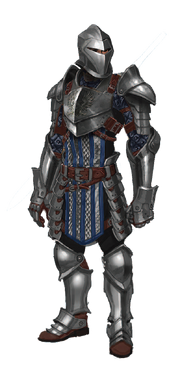
Grey Warden warrior
Grey Warden rogue
Grey Warden Mage
The First Blight and the founding
The First Blight occurred in -395 Ancient (395 years before the Chantry calendar), or 800 TE (800 years from the founding of the Tevinter Imperium), when a plague was unleashed upon the world. The Deep Roads, underground highways built by dwarves, were swarmed with monstrous creatures that became known as the "darkspawn". These creatures seemed limitless in number, and spread a taint that infected other living creatures, mutating them into monsters, and corrupted and poisoned the very environment around them. The cult of the Maker claimed this was the result of Tevinter mages entering the Fade through a ritual and attempting to usurp the Golden City, although dwarves and other non-humans discounted the theory. Nevertheless, this invasion of darkspawn — named the Blight — soon destroyed most of the underground kingdoms of the dwarves and spread to the surface world. Thedas was in chaos and entered a dark age. The darkspawn were found to be led by an immensely powerful dragon tainted with the darkspawn corruption; this creature was named an archdemon and believed to be one of the Old Gods worshipped by Tevinter.
In -305 Ancient (890 TE), after nearly a century of bitter war against the darkspawn hordes, a group of veteran warriors came together in Weisshaupt Fortress in the Anderfels, the western part of the Tevinter Imperium. Warden legends sing of their leader Carinus, and the sacrifice the founders made as they tried to save the world while their families perished. It is thought that Nakiri of The Donarks was the one who first suggested imbibing the blood of the darkspawn, as his people were known to consume the blood of their enemies to absorb their power. Tevinter mages in the group added to this knowledge, and it is said that elven slaves also contributed ancient knowledge from Arlathan. This was in return for being treated as equals in the order and with the intention that, after the Blight was ended, they would concentrate on freeing the elves. The Joining symbolically cut their ties to all worldly concerns, in order to dedicate themselves to fighting the darkspawn. They called themselves the Grey Wardens, and would accept anyone, no matter their race or background, without distinction if only deemed suitable to join the order.[2]
The Grey Wardens first appeared on the battlefield during the attack on Nordbotten, arriving mounted on griffons, plunging into the darkspawn with each Warden taking on crowds of ten or twenty darkspawn at once. The commanders of the griffon forces were knows as High Constables. [3] Incredibly, they broke the horde and won the battle. They proved to be a desperately needed spark of hope in the darkest of hours, and quickly gained renown since. The Grey Wardens started receiving tithes, supplies, and recruits from all lands; they grew, building fortresses and functioning as elite shock troops making quick and devastating strikes wherever darkspawn appeared, as well as rallying the mundane armies to greater deeds.
During the next 100 years, humanity slowly managed to stand firm and push back the Blight. Finally, in -203 Ancient (992 TE), the Grey Wardens gathered an allied army composed of soldiers from the Tevinter Imperium, the tribes of the Ciraine (the lands that would become Orlais), and Rivain to confront the main darkspawn horde, led by the archdemon now identified as Dumat. The massive battle was waged at the Silent Plains, in what is now southern Tevinter or northern Nevarra: the legion of darkspawn was defeated and Dumat was slain by the Grey Wardens: with the archdemon's death, the horde's will to fight on was broken. It took several years to eradicate the remaining darkspawn from the surface, but the deed was done and the Grey Wardens had carved out their legend. After the Battle of the Silent Plains, they were much celebrated and most nations gave formal promises of support for further darkspawn invasions. The Grey Wardens were also given the Right of Conscription to guarantee sufficient recruits.
The Second Blight
In 1:5 Divine, approximately 200 years since the slaying of Dumat, the archdemon Zazikel rose to lead the Second Blight. The entire city of Nordbotten — the very place where the Grey Wardens first appeared on the battlefield — was destroyed before a defense could be organized. The Tevinter Imperium withdrew from the Anderfels, abandoning it in an attempt to protect central Tevinter. The Anderfels area was in much trouble, and even the Grey Warden headquarters in Weisshaupt came under siege by the darkspawn.
Fortunately, the armies of the recently founded Orlesian Empire under the command of Emperor Kordillus Drakon I proved both motivated and capable of standing up to the Blight. After several victories against the darkspawn, Drakon's army lifted the siege of Weisshaupt in 1:33 Divine and proceeded to save the rest of the Anderfels together with the Wardens. The Anderfels joined with the Orlesian Empire.
In the following decades, the Blight was again slowly pushed back and the Grey Wardens took command of the war. The archdemon Zazikel was finally confronted and slain by Grey Wardens in 1:95 Divine at Starkhaven in the Free Marches.
The Third Blight
The Third Blight began with the awakening of Toth in 3:10 Towers, roughly 200 years after the last Blight. The initial darkspawn attacks occurred in central Thedas in Tevinter and Orlais, but even though the hordes were larger than those previously encountered, a rapidly-organized defense led by the Grey Wardens managed to hold them back. The darkspawn attacks started to focus on the more lightly defended Free Marches while Tevinter and Orlais tried to remain neutral, but pressure from the Grey Wardens eventually brought them into the war. The darkspawn horde was crushed at Hunter Fell in the Free Marches in 3:25 Towers, and Toth was slain by the Grey Wardens. The third Blight remained a relatively short event compared to previous Blights.
The Fourth Blight
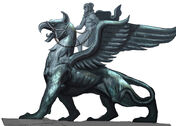
A Grey Warden mounted on a griffon.[4]
Not much is told about the Grey Wardens for another 200 years, when Andoral awakened and the Fourth Blight began in 5:12 Exalted. Most of the damage was to the east of traditional Grey Warden territory, in the Free Marches, Antiva, and Rivain, but the Anderfels was also attacked and Hossberg, not far from Weisshaupt, came under siege. This time, both Tevinter and Orlais were lightly attacked and refused to send aid. The hero of the fourth Blight was an elven Grey Warden named Garahel, who first led the liberation of Hossberg in 5:20 Exalted and then managed to gather an army from the Free Marches to support the Grey Wardens. Garahel's army marched north and faced the main horde in 5:24 Exalted at Ayesleigh, where Garahel perished after personally slaying Andoral.
The Grey Wardens' legendary griffons died out some time after the Fourth Blight.[5]
Exalted Age to Dragon Age
After the fourth Blight, the influence of the Grey Wardens waned considerably. It would be 400 years before the fifth Blight, and many started to think it would never happen. So many darkspawn were slain during the Fourth Blight that many came to the erroneous conclusion they were defeated permanently. Although remaining an eternal threat to the dwarves, darkspawn were rarely seen by surface people, and the Grey Wardens were slowly dismissed as a relic of a bygone, darker time best left forgotten.
In the vicinity of 7:10 Storm (counting backward from other dates given), there was an awkward incident in Ferelden with the local Warden-Commander—Sophia Dryden, previously a rival for the crown of Ferelden—becoming involved in a planned coup d'état. The result was fighting between the Grey Wardens and the royal army, the loss of Commander Sophia and her command at Soldier's Peak, and King Arland banishing the order from Ferelden—although it became a close thing with the Grey Wardens; a force of less than one hundred, nearly defeating the entire Fereldan army[6]). The Grey Wardens were allowed back in Ferelden by King Maric in 9:10 Dragon and they were able to begin a slow rebuilding, but by 9:30 Dragon, their presence remained light and the order was neither well known nor held in high regard by Ferelden's people.
The Fifth Blight
In 9:30 Dragon, the Fifth Blight finally began with the Architect trying to free the darkspawn from the call of the Old Gods by inducing Grey Warden blood to the unearthed Old God Urthemiel, believing it would help unravel the darkspawn's compulsion to seek the Old Gods at its source. Unfortunately, the experiment went horribly wrong and resulted instead in the awakening of a new Archdemon. The darkspawn swarmed the Korcari Wilds in southern Ferelden, where they were met by the Fereldan army under King Cailan and Loghain Mac Tir as well as all of Ferelden's Grey Wardens. After a few minor victories against the darkspawn, the royal army was devastated in a major battle at Ostagar when Loghain unexpectedly withdrew, leaving King Cailan and the Grey Wardens to their deaths. All but two Grey Wardens were slain in the massacre; both survivors were new recruits to the order.
Loghain installed himself as regent of Ferelden, denounced the Grey Wardens of Ferelden as traitors and had the Grey Wardens of Orlais that had come to assist Ferelden turned back at the border, believing the Wardens' claims about the Blight a ruse to assist in a new Orlesian conquest of Ferelden. Having heard what happened at Ostagar, the Grey Wardens decided to dispatch a Grey Warden native to Ferelden, Riordan, to fight Loghain and the Blight simultaneously. From their perspective, if the Grey Wardens expended themselves against Loghain, then they would risk the Blight devastating Thedas once again. Thus, they had to maintain vigil should Ferelden fall to the Blight.
Despite the odds, the remaining Grey Wardens were able to organize an allied army to oppose the Blight using old treaties, and with the aid of Riordan, managed to slay Urthemiel during the Battle of Denerim. The fifth Blight lasted just over one year. In acknowledgement of their efforts, the Grey Wardens were granted the arling of Amaranthine to allow them to rebuild.
The Awakening
Organization
The order of Grey Wardens is commanded by the First Warden in Weisshaupt, and consists of a system of semi-autonomous national branches lead by a local commander. Though there is a hierarchy, in practice the "pecking order" is frequently defined by seniority (decided by time of Joining) in the order.
At the time of Dragon Age: Origins in 9:30 Dragon, the strength of the Grey Wardens is estimated at over 1,000 in the Anderfels, several hundred in Orlais, and around two dozen in Ferelden.
The official hierarchy of the Grey Wardens, in descending order, is:[7]
- First Warden: permanently situated at Weisshaupt fortress, can recall Commanders at any time
- High Constable: second-in-command to the First Warden, and formerly the aerial commander during the Wardens' use of griffons.[8]
- Chamberlain of the Grey: the senior achivist at Weisshaupt, and to whom Warden Commanders send yearly reports
- Commander of the Grey: the leader of the Grey Wardens in a given country, and under normal circumstances under little direction by the order
- Warden-Constable: a Warden-Commander's second-in-command
- Senior Warden (or Warden Lieutenant in Orlais): commands a small group of Wardens or undertakes special missions
- Warden (or Warden-Ensign): a recruit who has survived the Joining
- Warden-Recruit: an individual selected to join the Wardens but who has not yet undertaken the Joining ritual. Failed recruits' names are kept in the archives of Weisshaupt
The Right of Conscription
- "Men and women from every race; warriors and mages, barbarians and kings..."
- —Duncan, head of the Grey Wardens in Ferelden
Should they need to, the Grey Wardens possess the Right of Conscription; they may demand that any individual from king to criminal be drafted into their ranks. However — especially in Ferelden — this right is used sparingly for fear of political reprisal. Further complicating matters, the Grey Wardens don't accept just anyone. Only the best and brightest are invited. In addition, the fact that the Joining ritual kills many of its participants means that the draft may turn out to be a death sentence.
Despite the risks, elves in particular tend to be eager to volunteer for the Grey Wardens, as they recruit regardless of race or social standing and serving is considered by many an honor.[9] Mages are traditionally recruited one per Circle of Magi, and the young mage recruit serves as a Warden their entire life from then on.[10] Similar to serving a ruler, yet greatly removed from the degradation they may normally face in society, mage Wardens are given great respect and importance in the Order. Their facilitation of the Joining ritual is essential.
In the Dragon Age: Origins - Awakening expansion, the Warden-Commander can choose to use the Right of Conscription to recruit Anders and Nathaniel.
The Joining
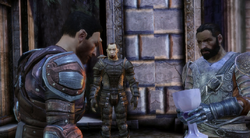
The Joining ceremony at Ostagar

A failed Warden recruit
“Join us, brothers and sisters. Join us in the shadows where we stand vigilant. Join us as we carry the duty that can not be forsworn. And should you perish, know that your sacrifice will not be forgotten. And that one day we shall join you.” ―The traditional words that begin a Joining
To become part of the Grey Wardens, a recruit must first go through a ritual called the Joining. One of the reasons for the small number of Grey Wardens is that few can survive this ritual. Only those who have a decent chance of surviving the Joining will even be made recruits. The ritual and the details about it are kept a strict secret by the Grey Wardens, because during the Joining, the recruits drink from a goblet containing a mixture of darkspawn blood, lyrium, and a drop of blood from an archdemon. Few survive this, but those who live become Grey Wardens — forever connected to the darkspawn, and forever tainted by the blood they have consumed.
Becoming a Grey Warden requires a dose of the darkspawn corruption in sufficient potency to have an immediate effect, rather than slowly corrupt the consumer into a ghoul. While archdemon blood is typically used, blood of other darkspawn creatures can also be magically treated to make it function in the ritual. However, the average darkspawn doesn't have enough of the corruption within it for this to work.[11]
The Joining ritual grants Grey Wardens several abilities: their link to the darkspawn's hive mind allows them to detect the presence of darkspawn and they become immune to further corruption by the Blight. However, they also suffer from bad (if occasionally prophetic) dreams, ravenous hunger, and shortened lifespans (most Wardens have only thirty years at most after their Joining before the taint consumes them). Also, while they can sense darkspawn, darkspawn can also sense them. As much of a boon as this dark gift is for the Wardens, it has also allowed them to be hunted by the darkspawn on occasion.
Avernus, when asked, states that the darkspawn taint conferred by the Joining contains incredible powers, with the ability to sense darkspawn as the least of such. He speculated that applications of energy and blood could unlock these powers, and endeavored to replicate the effects alchemically — leading to the Power of Blood talent tree.
The dwarves also hold the Grey Wardens in a such esteem that a King of Orzammar has decreed long before the events of the Fifth Blight that any dwarf who joins them retains the caste that they belonged to.[12]
The Calling
Just as they keep many secrets from outsiders, including the Joining, Grey Wardens also keep certain secrets hidden from many of their own members. As revealed in Dragon Age: The Calling, it is heavily implied that the Calling was a ritual created by the first Grey Wardens to prevent future members from watching themselves ultimately succumb to the darkspawn taint. Contrary to belief even among themselves, surviving the Joining does not confer to Grey Wardens a true immunity from "blight sickness", but rather merely delays its onset.
The Calling begins with nightmares or voices from the Old Gods, the same "call" the darkspawn hear to search for the Old Gods. Although Alistair claims it takes a person about thirty years after their joining to hear it, the gap varies depending on their willpower and the level of their interaction with the darkspawn. As such, Grey Wardens during a Blight are likely to have shorter lifespans. Otherwise, it is commonly between ten to thirty years that the Wardens hear the Calling.[13]
According to ritual, the Grey Warden descends underground and celebrates before entering the Deep Roads to slay as many darkspawn as they can before being overwhelmed and slain. The secret of the Calling is implied when Alistair reveals that the taint will kill the Grey Wardens, although this is not true. It is unknown whether the truth was kept from all the Grey Wardens or just its junior members such as Alistair, or perhaps not at all (it is quite possible that the senior Wardens simply did not get a chance to reveal the truth of the Calling to The Warden before the battle at Ostagar), but it is likely that only the first Grey Wardens with the exception of the characters in The Calling, knew the true nature of the Calling.
Riordan implied that even if a Grey Warden would run away, given time all Wardens would find themselves in the Deep Roads, Blight-Lands or pursued by darkspawn, for they all are connected by the taint that draws them to each other. "You'd seek them out... or they'd seek you out." Thus, one can assume that almost every Grey Warden will die at the hands of darkspawn.
Notable Grey Wardens
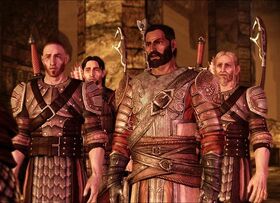
Duncan with fellow Grey Wardens in the Deep Roads, as seen in the Dwarf Noble origin.
- Main article: Grey Warden membership
- For a complete list of Notable Grey Wardens, see [[::Category:Grey Wardens]].
- Alistair
- Anders
- Avernus
- Bregan
- Corin
- Sophia Dryden
- Duncan
- Fiona
- Garahel
- Genevieve
- Janeka
- Kell
- Kilina: Grey Warden recruiter of the Orth people of the Anderfels.[14]
- Julien
- Kristoff
- Larius
- Nicolas
- Riordan
- Stroud
- Utha
- The Warden / The Warden-Commander
Grey Wardens mentioned in passing by Alistair:
- Grigor/Gregor: Notable for his excessive drinking and big, bushy beard. Alistair cannot recall his correct name.
- Kherek: A dwarf who went to his Calling before the Fifth Blight began (mentioned to a dwarven Warden who asks about dwarves in the order).
- Tamarel: An elf who kept to himself and did not appear to have joined the Wardens at Ostagar. According to Alistair he seemed to have had a hard life prior to becoming a Warden. It is possible he is still alive (mentioned to an elven Warden who asks about elves in the order).
Potential Grey Wardens, depending on player choices:
- Bethany Hawke
- Carver Hawke
- Secret Companion
- Nathaniel Howe
- Oghren
- Sigrun
- Velanna
- Justice (technically, through Kristoff's Joined corpse)
Known strongholds
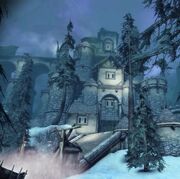
Soldier's Peak, once centre of Grey Warden strength in Ferelden.
Ferelden
- Soldier's Peak (defunct unless The Warden aids Levi Dryden)
- Amaranthine (including Vigil's Keep), granted to the Wardens following the Fifth Blight
Orlais
- Adamant fortress (abandoned)
- Montsimmard - Residence of the Warden-Commander of Orlais.
- Jader - Kristoff and his wife Aura lived there before he came to Ferelden
Anderfels
- Weisshaupt Fortress, official headquarters of the order, seat of the First Warden.
Free Marches
- Ansburg [15]
- Warden Prison
Heraldry
The heraldry of the Grey Wardens is an argent griffon segreant on azure. The Grey Warden Commanders (at least in the time of Sophia Dryden) seem to have their own heraldry as well. The blazon for that charge might be rendered as "two griffons addorsed, wings elevated, maintaining a branch fesswise". On Sophia Dryden's Warden Commander Armor, the charge appears in or on a field sable. The artistic rendition of the charge on the armor is distinct from that seen on the heavier metal shields.
Related codex entries
Codex entry: The First Blight, Chapter 4
Trivia
- Dragon Age: The Calling by David Gaider gives further insight into many aspects of Grey Warden lore.
- The Grey Wardens bear resemblances to the Night's Watch in A Song of Ice and Fire: both are ancient organizations originally formed to defend against a specific threat; both have declined significantly in power and status; both are generally willing to recruit members regardless of past history or social status, criminals and nobility rendered equals within their ranks.
- The order also resembles that of the Knights Templar. Parallels can be seen by comparing the Blights to the Crusades; the small numbers each organization started with; secretive initiation rituals; and being abolished or banished (the Wardens in Ferelden by King Arland, the Knights Templar in France by King Philip IV).
- The Grey Wardens also resemble witchers, as in The Witcher series by Andrzej Sapkowski. Like witchers, the Grey Wardens are sworn to fight monstrous entities; they undergo intense procedures which fortify them to fight their enemies; both are effectively sterile. Morrigan refers her lover to tales of the Grey Wardens' "endurance"; witchers have a notoriety for sexual appetite and (complementary) immunity to disease (recalling the Joining and its consequent Blight Disease resistance).
- They also bear similarities to Male Channelers and people from the Borderlands in Robert Jordan's The Wheel of Time. Male Channelers suffer from a taint that will eventually drive them mad and kill them. Borderlanders share the aspect of being sworn to defend the land against the Great Blight and the Shadowspawn that dwell there.
- Becoming a Grey Warden seems to lend itself to greater powers, aside from being able to sense darkspawn. This is evidenced by the Joining - which grants 1 attribute point and 1 ability/spell - and (optionally) by the Power of Blood.
- Weisshaupt Fortress' name may be inspired by that of the founder of the Order of Illuminati, Adam Weishaupt. (For added resonance, his son Karl was Bavaria's War Minister - a title well-suited to most high-ranking Wardens.)
- To date, it is not known if there are (or have been) any Qunari in the order. Given the very specific roles written in the Qun and that the Qunari seem ever distant from the Blights, a Qunari Warden would most likely be considered Tal-Vashoth - quite apropos to Tal-Vashoth's translation as 'True Grey'.
- Alistair's exposition of the Grey Wardens hearing the Calling thirty years after their joining was something David Gaider regretted adding, since it is "a long time for that time frame." Although it was not really his intention when this was written, he clarified that the number varies.[13]
Gallery
References
- ↑ Dragon Age: The World of Thedas Vol. 1, page 154.
- ↑ Dragon Age RPG Game Master's Guide, set 2, pg. 3.
- ↑ D Gaider; B Gelinas; M Laidlaw (2013). Dragon Age: The World of Thedas. Dark Horse. p154.
- ↑ Image taken from Dragon Age: The World of Thedas, vol. 1, pg. 151.
- ↑ Dragon Age: The World of Thedas, vol. 1, pg. 151.
- ↑ King Maric in Dragon Age: The Calling
- ↑ http://social.bioware.com/forum/1/topic/371/index/16570849/3
- ↑ http://dragonage.wikia.com/wiki/High_Constable%27s_Mace
- ↑ Dragon Age: The World of Thedas Vol. 1, page 151.
- ↑ Dragon Age: The World of Thedas Vol. 1, page 151.
- ↑ Forum post by David Gaider on Bioware Social Network
- ↑ Acquired by talking to Leske during the Proving Loyalties quest.
- ↑ 13.0 13.1 Thedas UK (January 14, 2012). "David Gaider Interview". Retrieved January 29, 2012.
- ↑ Dragon Age RPG, set 2, Game Master's Guide, pg. 54.
- ↑ Bethany mentions a Warden keep at Ansburg in the Comic Con Legacy demo




